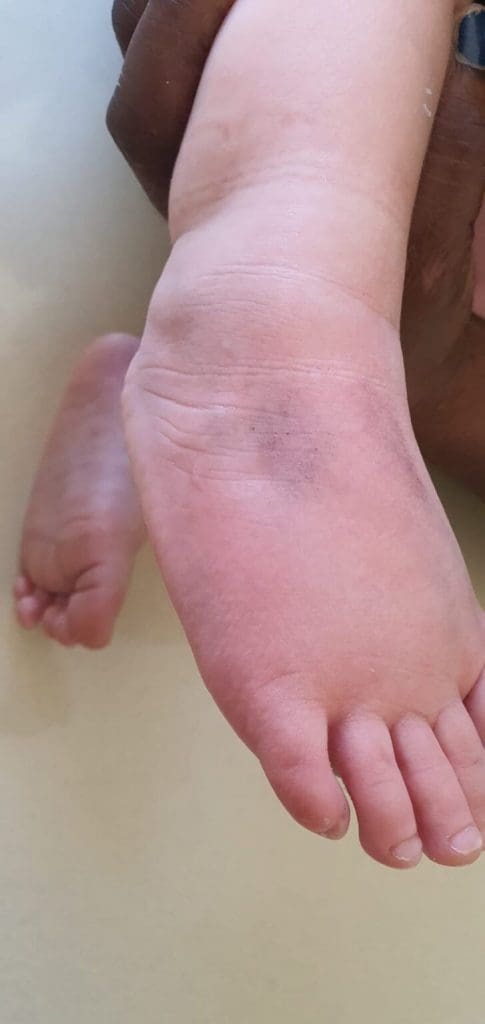
Is it a sprain or a fracture?
The kid fell and hurt an arm or a leg. How will we know if it’s fractured? Or is it a sprain? Should an X-ray be done or is waiting acceptable?
We will try to summarize a few general principles.
Please note that in this chapter, I attempt to focus on limb injuries, another chapter that discusses head injuries is available for you here.
Note the mechanism of injury:
The mechanism of injury is an extremely important phrase in pediatrics and is directly related to the decisions that we are going to make later.
Meaning, there’s a difference between a child that climbed the school fence and landed with their hand on concrete after a 3-meter fall, and a six-month-old that stumbles on a carpet in the living-room.
This is not to say that the first case will necessarily end with a fractured arm, nor that nothing will happen in the second case, but there’s a difference.
So, if the mechanism of injury is significant, treat it with caution and get examined.
Note the local findings in the area of injury:
It’s a bit hard to give universal guidelines but look at the area of the injury. Note signs like a deformity (abnormal position) swelling or blue discoloration (sign of bleeding). In case of an abnormal position or substantial swelling, proper check-up is required.
Note the movement of the limb after the injury and carriage of weight:
A fracture hurts. In a case of an incomplete fracture as well, usually the child will noticeably avoid using the arm or leg and movement will be extremely painful.
If a leg injury is at hand, a typical finding is inability to carry weight on that leg. A child that is running relatively freely, even if with a limp, in most cases (and there are exceptions of-course), is not suffering from a fracture.
I’ve seen a few cases of children in which the fracture was diagnosed a few days late, after the parents had noticed the child holding the arm in an abnormal way or avoids movement. So please, pay attention to these things and if in doubt, get it checked and consider an X-ray.
Notice the accompanying injuries:
We are talking about limb injuries, but other accompanying injuries of other organs may exist. Check that the child hasn’t didn’t injure their head and note whether the child is moving all other limbs besides where they got hurt directly.
When to suspect a fracture?
Again, a combination of a significant mechanism of injury, local findings and most importantly, pain and inability to move the limb. This would be the case to go get checked and get an X-ray.
Remember that the wrist joint area (the carpal and forearm bones) is another confusing area that may hide a fracture that may take several days to diagnose. Therefore, after a significant injury to this area or sensitivity in its movement, I recommend getting assessed.
What is a sprain and when should it be suspected?
A sprain is an injury to a ligament or the joint capsule. In most cases in children, the sprain is in the area of the ankle, with a typical history of twisting of the ankle while stepping on it. Sometimes a small “puck” can be heard and in most cases local swelling appears, in the area of the lateral or medial malleoli (the bony bumps on both sides of the ankle). The swelling can be bluish in color (evidence of bleed). See the photo.
There are three grades for a sprain, from a mild pull and up to a full tear of the ligament (grade 3) accompanied with instability of the joint.
Treatment in most cases includes analgesia (pain killers) and splinting of the area with an elastic band. In cases of significant swelling, immense pain or inability to carry weight on the foot, medical consultation is mandatory. This is possibly not a sprain.
Should we treat a child with pain killers after an injury or will it “mask” the true diagnosis?
If the child is injured and in pain, analgesia may be used. Having said that, note the signs above to distinguish an injury that is simply painful and an injury that hides a fracture. In my opinion, pain killers will not mask this distinction.
In injuries, should warm or cold compresses be used?
This question gets asked a lot in a topic that confuses many parents.
In the acute phase of the injury, when there’s bleeding inside the tissue a cold compress may be used in order to contract the blood vessels and prevent bleeding.
After a while, let’s say, a day, an inflammatory process may develop and warm compresses can then be used to reduce the inflammation slightly.
In conclusion, not an easy chapter, I know, because it is hard to give universal answers and every case of injury is different from the other. Anyway, I hope this chapter will be helpful in case the child is injured.
For comments and questions, please register
